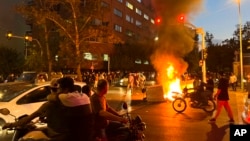As protests in Iran over the death of a young woman in police custody spread to about 80 cities, authorities have responded by arresting protesters and journalists, many of them women.
As of Friday, media rights groups tracking the arrests of journalists who covered the death of Mahsa Amini, 22, and the ensuing protests have documented the detention of at least 28 journalists.
"With the current crisis — the protests after Mahsa Amini's death — we have seen an unprecedented stifling of the press, and we see women to be one of the primary targets," said Kiran Nazish, founding director of the Coalition For Women In Journalism (CFWIJ), a grassroots organization that focuses on the protection of women and LGBTQ journalists.
Nazish told VOA that although CFWIJ has been able to confirm the location of several of the imprisoned journalists, "we don't even know which authorities took" the others.
In Iran, she said, "journalists are being imprisoned and then they just disappear."
The New York-based Committee to Protect Journalists (CPJ), which is also tracking arrests, has said that many are taken from their homes at night by agents who do not provide court documents or arrest warrants. Many of those detained have not been formally charged.
Others targeted
Reporters are not the only ones targeted. The Iranian Human Rights Organization, a nonprofit based in Norway, has reported that at least 83 protesters have been killed and thousands arrested.
Security agents have fired into crowds with live ammunition, and families have been threatened with legal action to prevent them from speaking out about the deaths, the organization reported.
Iran's mission to the United Nations did not respond to VOA's email requesting comment.
Internet blackouts and the blocking of social media apps have made it difficult to get information from Iran.
"The regime does not want news of their brutal crackdown to get out," Yeganeh Rezaian, senior researcher at CPJ, told VOA. "They don't want people to be connected with each other and with the outside world."
Despite restrictions, the CPJ and CFWIJ have been working to protect journalists and to ensure the rest of the world sees what's happening.
For the CFWIJ that has meant working directly with journalists and activists on the ground in Iran who are connected to the local communities. Nazish said that because of the increased threats, her contacts have had to change locations and use assumed names.
Lack of authorities' response
Even before the protests, advocating for imprisoned journalists in Iran was much different from what CFWIJ is able to do in the 127 other countries where it works.
Typically, lawyers are the main line of communication, but in Iran they are often kept from speaking to journalists.
"One of the biggest challenges, even before this moment that we're in right now, has been that Iranian authorities don't respond. You can't get in and you can't talk to the journalist no matter how much we push back," Nazish told VOA.
Appealing to opposition leaders and members of the government are also nearly impossible because of state control. "The only people who are there as stakeholders are other activists, who are also under threat," Nazish said.
And moving at-risk journalists to a safer country is problematic.
When the Taliban took control of Afghanistan in August 2021, the CFWIJ was able to safely evacuate 402 journalists.
But in Iran, removing people has not been an option. There, authorities often confiscate documentation from detained journalists, preventing them from obtaining passports even after they are freed.
Prior to the protests and arrests, Iran was already on CFWIJ's radar for its treatment of women.
Female journalists faced salary disparities, restrictions on the stories they could cover, gender-based attacks on social media, threats to family members and physical violence, said Nazish.
"Women journalists don't really work in an industry that is very advantageous for them," Nazish told VOA. "It's not that they're enjoying a thriving career as a journalist in Iran. They're doing it because they care about democracy, equity, civil society. They care about their rights as women, they care about what's happening to the people of Iran, and they are committed to that work."
An Iranian journalist living in the United States, Rezaian of CPJ, said that women's voices are essential in countries like Iran and Afghanistan where men "may not necessarily be welcomed or allowed in all female sections of that community."
Years of repression
The current protests in Iran have been led by women and come after decades of repression.
"In the last 44 years, the Islamic Republic has tried to put women to the sideline and treat them as second-class citizens," said Mahtab Divsalar, senior editor of Zamaneh Media. The independent Persian-language news organization is based in Amsterdam.
"They just want to reduce the face of women from society. They're doing this with their laws that they are imposing, with their propaganda, and also with their own narrative," Divsalar said.
Divsalar, who spent eight years reporting in Iran before leaving for the U.S. and later Amsterdam, said the current protests are not just about the compulsory wearing of the hijab. Women are fighting for other basic rights, including the rights to divorce and to receive equal inheritance.
The journalist has reported for several news outlets, including VOA Persian.
Rezaian of CPJ also believes that a lack of social and press freedoms as well as human rights abuses and economic pressure have contributed to the current situation in Iran.
"All these led to an environment of suffocation that the younger generation doesn't want to tolerate anymore," she said.
Nazish believes it will take "international pressure" to ensure imprisoned journalists in Iran are released.
"Essentially, Iran wants to stifle the press," Nazish told VOA. "They don't want massive media coverage of what women are talking about … they don't want a civil society that is mobilized … and they want to silence the press that is trying to cover that."











